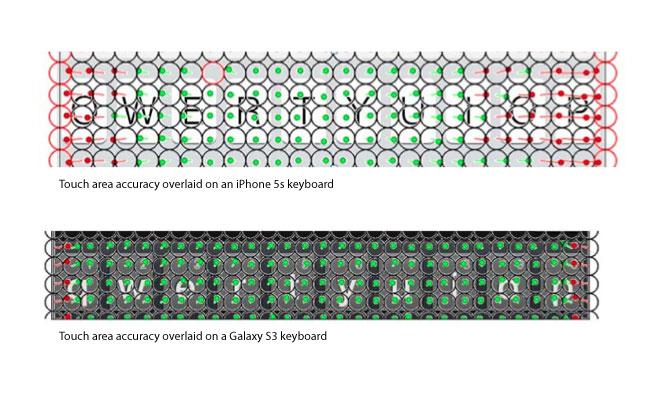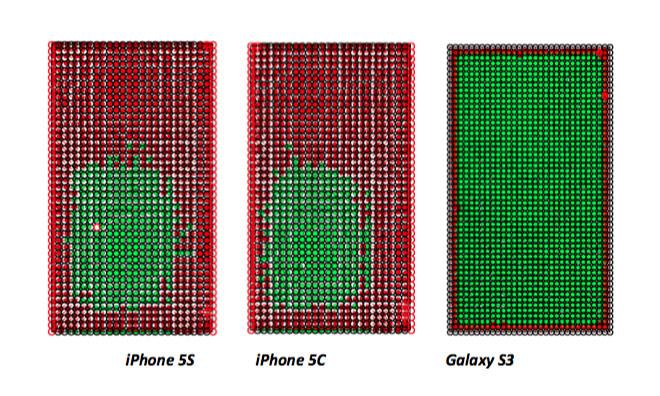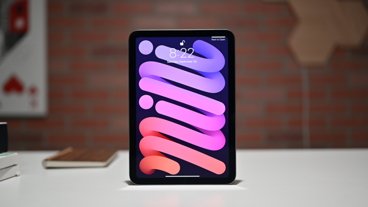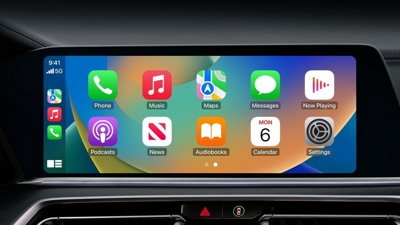The touchscreens on Apple's flagship iPhone 5s and mid-range iPhone 5c show significant degradation in touch detection accuracy along their edges, which can affect hitting outside keys on the iOS virtual keyboard, new test data shows.
Green points indicate measurements within ± 1 mm. Red points indicate measurements in excess of 1mm. Black circles show the robot's touch point. | Source: OptoFidelity
Using a robotic finger and a specialized suite of test software, Finnish automated testing company OptoFidelity found that Apple's latest handsets accurately detect touch inputs only across a small swath of their displays, roughly equating to the location of the on-screen keyboard.
The iPhone 5s and 5c, according to the company, suffer from "extremely bad" touch performance near the edges of the display. This makes it difficult for users to hit outlying keys on the virtual keyboard, like Q, O, and P, the report says.

Touch accuracy measurements overlaid on an iPhone 5s keyboard, top, and a Galaxy S3 keyboard, bottom | Source: OptoFidelity
OptoFidelity compared the iPhones' displays to that of Samsung's Galaxy S3 and found that the Korean phone offered significantly more accurate touch detection across its entire touch surface.
"Because the touch accuracy is more even in Galaxy S3 than in iPhone 5s and iPhone 5c, you get a lot less typing errors, and letters which are close to the edge are working better," the report said.
The test methodology considers a difference of less than one millimeter between the robot's reported position and the touch screen's reported position to be "accurate."
The analysis marks a change from 2010, when testing showed that the iPhone display was by far the most accurate among smartphones then available on the market. That test from three years ago was conducted by drawing lines on the screen, and measuring how straight they would be.
While the latest test suggests the outside of Apple's iPhone displays may experience inaccuracies, the iPhone still leads the way when it comes to responsiveness. One study published last month by Agawi found the iPhone 5 display to be twice as fast as competing Android-based handsets.
 Shane Cole
Shane Cole







-m.jpg)






 Amber Neely
Amber Neely
 Mike Wuerthele
Mike Wuerthele
 William Gallagher
William Gallagher


 Andrew Orr
Andrew Orr
 Wesley Hilliard
Wesley Hilliard






146 Comments
Well. Good thing I'm not a robot!
"While the latest test suggests the outside of Apple's iPhone displays may experience inaccuracies, the iPhone still leads the way when it comes to responsiveness. One study published last month by Agawi found the iPhone 5 display to be twice as fast as competing Android-based handsets." Hmm. . . So faster mistakes then according to AI. What an odd way to attach a positive to a negative finding (if true). :err:
What I've seen in iPhone 5 and 5s (but not in 4S and previous versions) is a greater probability of trying to type M, L or N and ending up deleting the previous character instead.
It's about time this type of testing is done and reported.
Touchgate!
Never had this issue with a single iPhone that I've used. If anything, the keyboard problems I've had most often occur with the keys in the middle -- e.g., G/H, U/I/O. Also, are the edges 'numbed' on purpose, to prevent accidental touch from the bezel?